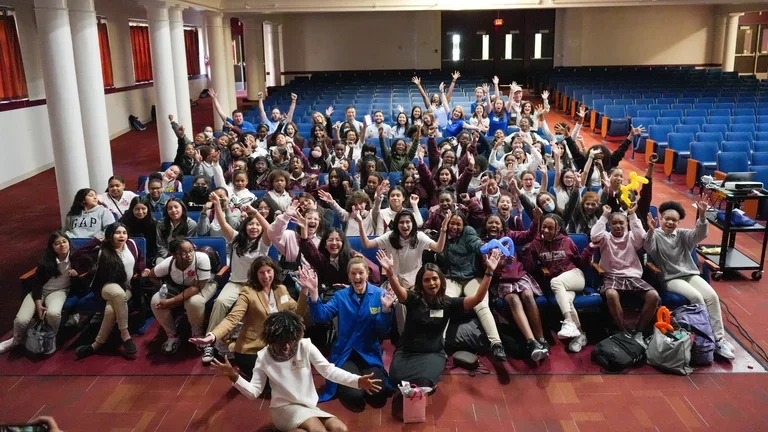Celebrating Women's History Month by Shaping the Next Generation of Women in STEM
Katie Ellet, President, Hydrogen Energy & Mobility, North America
Published on March 24, 2023
5 minutes

For generations, from Marie Curie to Sally Ride and Jessica Watkins, women have been on the frontlines of science and technology - leading discoveries about our world, pioneering medical breakthroughs, and seeing missions off to Mars. That’s true, but not necessarily something you would know by walking into a Houston area classroom or a local engineering or manufacturing facility.
This International Women’s Day offers an opportunity to celebrate the achievements of women, but it also provides a moment for us to meaningfully consider how we are supporting and shaping the future of the American workforce and the next generation of women.
Today, despite women accounting for roughly half of our workforce, we only make up one-third of those in STEM occupations. Those numbers drop even lower for women of color (11.6%).
The representation of women has improved over the years, but there is still a long way to go in achieving gender equity and increasing the number of women in STEM fields.
This is a problem (and a big opportunity) not only for women, but for everyone. STEM careers including manufacturing, long the engine of the American economy, are experiencing a troubling skills gap. Companies are struggling to find enough workers to fill skilled positions. In a public survey conducted by the Pwc Research Center, a majority of executives identified the digital transformation and retaining talent as the most critical growth drivers facing their industries. By some estimates, at least 85 million high-tech, and high paying, jobs could go unfulfilled globally in the next decade.
Leaving this dynamic unaddressed cannot be an option. If we want to grow our future workforce, we have to start right now and with everyone. Our workforce, our industries, and our economy as a whole are only as strong as the people who participate. It is therefore essential that we understand the root causes for the dearth of women entering STEM occupations and create a supportive and inclusive environment to attract and retain more women in these fields.
At least one can be found in educational opportunities. While boys and girls take the same number of math and science classes in elementary, middle, and high school, fewer women opt to focus on these subjects as a major at university. In physics, engineering, and computer science, for example, only 20 percent of graduates earning a bachelor’s degree in these fields are women.
We can all take ownership for this issue – by encouraging the young women in our lives who show an interest in math and science, by identifying role models in these fields, and by supporting mentorship opportunities and programs. At Air Liquide, one way that we have chosen to be a part of the solution is by partnering with Dr. Kate Biberdof, better known as “Kate the Chemist,” a chemist, science entertainer, and professor at The University of Texas.
Air Liquide hosted an event with Dr. Biberdorf for the sixth and seventh graders at the Young Women’s College Preparatory Academy in Houston featuring science experiment demonstrations and a panel discussion on the importance of STEM education for young women. Our hope is that by showcasing women who are active in the fields of science, engineering, we are encouraging enthusiasm for STEM subjects and providing a roadmap for girls interested in pursuing a science-based professional path.
Beyond any altruistic value of support for young women, there is a strong business case for the private sector making investments in developing a diverse workforce. Like many leading global companies, Air Liquide is committed to ensuring that women are well represented across all levels of the company. For example, we’ve set a goal of increasing the representation of women to reach 35 percent of our professionals, including engineers, within the next two years. Longer-term, we hope to increase that percentage even further, and so it is in our interest – and that of our industry writ large – to have an expanded and competitive pool of young talents .
A diverse workforce is also beneficial in achieving our environmental goals. The United States has set an ambitious target of reaching net-zero carbon emissions by 2050.
As a provider of hydrogen and biogas, Air Liquide is focused on supporting the clean energy transition and enhanced sustainability for our customers. This transition requires the collaboration of the very best minds to drive R&D and deploy clean energy technologies. To seize these opportunities, we will need an ever-increasing number of highly skilled, STEM-educated workers.
Our world is changing. I thought about that when I stood next to Secretary of Energy Jennifer Granholm after a plant tour at one of our hydrogen facilities last year. Secretary Granholm has been an outspoken advocate for the need for greater diversity in our STEM workforce and, under her leadership, the Department of Energy launched a STEM portal providing students and educators with resources to support access to educational tools and materials.
Together, we must continue to push forward. If we want to realize the economic and climate benefits of a zero-carbon economy in the coming years, then we need to invest in a talented, diverse workforce that can deliver on the promise of our energy transition. By working towards this goal, we must attract and retain highly qualified women who will help shape the face of the future.
Written by:
President, Hydrogen Energy & Mobility,
North America, Air Liquide Hydrogen Energy
#TheFutureisFemale


